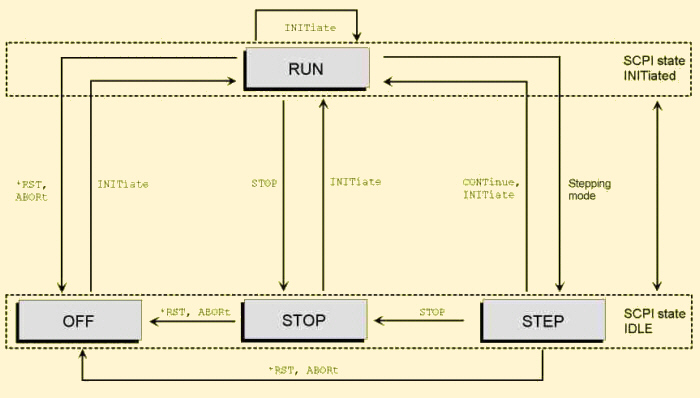


Measurement control commands are used to switch over between the following four measurement states:
| OFF | measurement is switched off, no results available (after
STOP) |
| RUN | measurement is running |
| STOP | measurement has been stopped, valid results are preserved |
| STEP | measurement has been interrupted after a statistics cycle
(in repetition mode Continuous or Counting with Stepping mode set in addition).
The next cycle must be launched with a CONTinue command.
|
The STOP state corresponds to the HLT state indicated next to the softkeys controlling a measurement in manual operation. A STEP state is not defined in manual control.
The three measurement states OFF, STOP, and STEP can be mapped onto the standard SCPI state IDLE, the RUN state can be mapped onto the SCPI state INITiated. This and the relation between control commands and measurement states is shown in the following diagram:

Measurement states and control commands
The measurement control commands are supplemented by the measurement object, i.e.:
INITiate:<meas_obj> |
Starts a measurement in the repetition mode set via the CONFigure:<meas_obj>:CONTrol:REPetition
command (single shot, continuous or counting mode, see section Measurement
Statistics). The command resets the counters for the evaluation period
and statistics (the latter is not used in RF measurements) to zero, furthermore,
all measurement values are set invalid (INV).
As illustrated in the figure above, The measurement reserves all necessary hardware resources
and switches into the RUN state. If the measurement can not be
started due to a resource conflict it remains in the OFF state,
and the measurement status returned by the |
| Possible resources conflicts |
The RF connector is already allocated by another measurement
or signal generator. The other measurement must be switched off first.
Due to the method used for the analysis, two measurements can not be evaluated at the same time. |
| Overlapping execution | INITiate is
implemented as an overlapped command. In contrast to SCPI specifications,
the *OPC command (see Common
Commands) can not be applied together with the INITiate
command. The operation complete bit (bit no. 0 in the event
status register, ESR) is set immediately after the command sequence INIT;
*OPC, i.e. as soon as the measurement is started and not after
the end of the first evaluation period. |
The command CONFigure:<meas_obj>:EREPorting <Event>,
<Mode> represents a more flexible tool for generating a service
request or setting the operation complete bit after the end of
a measurement (see section Event Reporting
). | |
READ command |
Instead of INITiate, the READ command
can be used to initiate a (single shot) measurement, see section Retrieving
Measurement Results. |
ABORt:<meas_obj> |
Aborts the current measurement immediately and switches over
to the OFF state. All measurement values are set invalid (INV);
the hardware resources are released for other measurements.
As illustrated in the figure above, |
| Sequential execution | ABORt is implemented
as a sequential command. This means that ABORt is not complete
until the measurement has released all resources and has changed to the
OFF state. |
|
Stops (halts) the measurement as quickly as possible; i.e.
after the end of the current evaluation period (or statistics cycle, if
cycles comprising several evaluation periods are defined). The measurement
changes to the STOP state such that all corresponding measurement
values are kept unchanged. The hardware resources are retained.
As illustrated in the figure above, |
| Sequential execution | STOP is implemented
as a sequential command. Execution of STOP is considered
as complete as soon as the measurement state STOP is reached.
The |
|
Resumes the measurement for the next measurement evaluation
period and changes to the RUN state.
As illustrated in the figure above, In the other measurement states the command causes an SCPI
error |
| Overlapping execution | CONTinue is
implemented as an overlapping command like INITiate. As a
consequence, *OPC can not be used together with CONTinue.
|
| Stepping mode | The stepping mode determines whether a measurement in the
counting or continuous mode (see section Measurement
Statistics) is interrupted after each evaluation period (or each statistics
cycle, if cycles comprising several evaluation periods are defined) or
not. This mode is set via the <Stepmode> parameter
of the CONFigure:<meas_obj>:CONTrol:REPetition CONTinuous
| 1 ... 10000, <StopCondition>, <Stepmode> command: |
| <Stepmode> = STEP
The measurement is interrupted ( measurement state STEP) after each evaluation period, and the event reporting system (see Event Reporting ) is invoked. The next measurement cycle must be started with the CONTinue:<meas_object> command. | |
| <Stepmode> = NONE
The measurement runs according to its repetition mode. Event reporting is invoked only when the measurement stops (status = RDY). | |
| Note: STEP can be set in all repetition modes (single shot, continuous, counting). For a single shot measurement which is always stopped after one evaluation period, the stepping mode has no effect. |
In function group RF Non Signalling, <meas_obj> can stand
for any of the measurement objects POWer and SPECtrum.
Note: Some measurements rely upon the same system resources and cannot be performed simultaneously. The R&S CMU provides a mechanism to decide whether conflicting measurements are persistent or releasable; see section Task Priority Management.